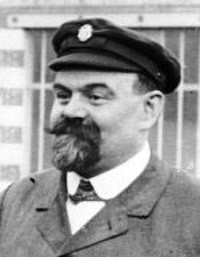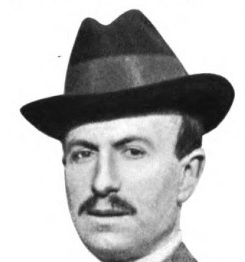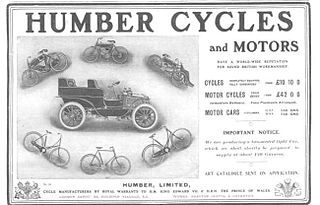
CarlFriedrich Benz was a German engine designer and automotive engineer. His Benz Patent Motorcar from 1885 is considered the first practical modern automobile and first car put into series production. He received a patent for the motorcar in 1886, the same year he first publicly drove the Benz Patent-Motorwagen.

Wilhelm Maybach was an early German engine designer and industrialist. During the 1890s he was hailed in France, then the world centre for car production, as the "King of Designers".

Gottlieb Wilhelm Daimler was a German engineer, industrial designer and industrialist born in Schorndorf, in what is now Germany. He was a pioneer of internal-combustion engines and automobile development. He invented the high-speed liquid petroleum-fueled engine.
The automotive industry in the United Kingdom is now best known for premium and sports car marques including Aston Martin, Bentley, Caterham Cars, Daimler, Jaguar, Lagonda, Land Rover, Lister Cars, Lotus, MG, McLaren, Mini, MOKE, Morgan, Rolls-Royce and TVR. Volume car manufacturers with a major presence in the UK include Nissan, Toyota, BMW, and Vauxhall Motors. Commercial vehicle manufacturers active in the UK include Alexander Dennis, Dennis Eagle, IBC Vehicles, Leyland Trucks, TEVVA and London Electric Vehicle Company.

The Daimler Company Limited, before 1910 known as the Daimler Motor Company Limited, was an independent British motor vehicle manufacturer founded in London by H. J. Lawson in 1896, which set up its manufacturing base in Coventry. The company bought the right to the use of the Daimler name simultaneously from Gottlieb Daimler and Daimler-Motoren-Gesellschaft of Cannstatt, Germany. After early financial difficulty and a reorganisation of the company in 1904, the Daimler Motor Company was purchased by Birmingham Small Arms Company (BSA) in 1910, which also made cars under its own name before the Second World War. In 1933, BSA bought the Lanchester Motor Company and made it a subsidiary of the Daimler Company.

Development of the automobile started in 1672 with the invention of the first steam-powered vehicle, which led to the creation of the first steam-powered automobile capable of human transportation, built by Nicolas-Joseph Cugnot in 1769. Inventors began to branch out at the start of the 19th century, creating the de Rivaz engine, one of the first internal combustion engines, and an early electric motor. Samuel Brown later tested the first industrially applied internal combustion engine in 1826. Only two of these were made.

Daimler-Motoren-Gesellschaft was a German engineering company and later automobile manufacturer, in operation from 1890 until 1926. Founded by Gottlieb Daimler (1834–1900) and Wilhelm Maybach (1846–1929), it was based first in Cannstatt. Daimler died in 1900, and their business moved in 1903 to Stuttgart-Untertürkheim after the original factory was destroyed by fire, and again to Berlin in 1922. Other factories were located in Marienfelde and Sindelfingen.
Daimler is a German surname. It may refer to:
The Garrard & Blumfield or Blumfield & Garrard was an English electric car manufacturer from 1894 to 1896. The company is presumed to have been founded by C. R. Garrard and T. W. Blumfield.

Léon Bollée was a French automobile manufacturer and inventor.

Henry John Lawson, also known as Harry Lawson, was a British bicycle designer, racing cyclist, motor industry pioneer, and fraudster. As part of his attempt to create and control a British motor industry Lawson formed and co floated The Daimler Motor Company Limited in London in 1896. It later began manufacture in Coventry. Lawson organised the 1896 Emancipation Day drive now commemorated annually by the London to Brighton Veteran Car Run on the same course.

Frederick Richard Simms was a British mechanical engineer, businessman, prolific inventor and motor industry pioneer. Simms coined the words "petrol" and "motorcar". He founded the Royal Automobile Club, and the Society of Motor Manufacturers and Traders.

Edward Joel Pennington was an inventor and promoter of many mechanical devices, including airships, motorcycles, and automobiles. In addition to motor vehicles, he applied for and received patents for Stirling engines, ignition systems, planing machines, and pulleys.

Humber Limited was a pioneering British motorcycle manufacturer. Humber produced the first practical motorcycle made in Britain by fitting one of their Humber bicycles with an E. J. Pennington two-horsepower motor in 1896.

The Locomotives on Highways Act 1896 removed the strict rules and UK speed limits that were included in the earlier Locomotive Acts which had greatly restricted the adoption of motorised vehicles in the United Kingdom. It came into operation on 14 November 1896.

Herbert Osbaldeston Duncan (1862–1945) was an English racing bicyclist, journalist, and pioneer of the British automobile industry. Duncan became interested in cycling during his time at Taplow College, and in 1878 he joined the Belgrave Bicycle Club determined to make a career in the sport. He became a well-known cycling journalist and later founded the Motor Review.

The Coventry Motor Company or CMC was a Coventry motor vehicle manufacturer established in early 1896 by H J Lawson's secretary Charles McRobie Turrell (1875–1923) as a subsidiary of Lawson's British Motor Syndicate.

The Great Horseless Carriage Company Limited was formed in May 1896 with a capital of £750,000 in shares of £10 each "of which £250,0000 was for working capital". The company was formed to carry on the horseless carriage industry in England and works with railway and canal adjoining were secured at Coventry. The rights that were purchased had little lasting value and after a number of financial reconstructions beginning in 1898 all activities were terminated by 1910.

John James Henry Sturmey (1857–1930), known as Henry Sturmey, is best remembered as the inventor with James Archer of the Sturmey-Archer three-speed hub for bicycles, but he was a technical editor and journalist heavily involved as a pioneer of the cycling and automotive industries. Born at Norton-sub-Hamdon, Somerset, on 28 February 1857 he died aged 72 at his home in Coventry on 8 January 1930.

Motor Manufacturing Company Limited, incorporated 1902 following companies of the same name formed in 1898 and 1900 was the third and final revival of H. J. Lawson's The Great Horseless Carriage Company.























